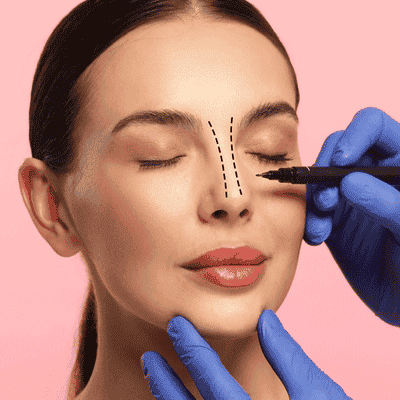Common Myths About Rhinoplasty Surgery Explained
Rhinoplasty, often referred to as a “nose job,” is one of the most commonly performed cosmetic surgeries worldwide. Whether for medical or aesthetic reasons, rhinoplasty can significantly impact a person's quality of life. Yet, despite its popularity, a number of myths continue to surround the procedure—especially in regions like Oman, where modern cosmetic surgery is gaining traction.For individuals considering Rhinoplasty Surgery Oman, it's important to separate fact from fiction. This guide aims to clarify the most common misconceptions and offer reliable, expert insight to help you make an informed decision.

Myth 1: Rhinoplasty Is Only for Cosmetic Reasons
One of the most widespread myths is that rhinoplasty is purely cosmetic. While it's true that many people choose the procedure to enhance the shape or size of their nose, rhinoplasty is often medically necessary.Functional rhinoplasty is performed to correct issues such as a deviated septum, chronic breathing problems, or structural damage due to injury. Many patients in Oman seek rhinoplasty not only to improve appearance but also to enhance breathing and overall nasal function.
Myth 2: The Results Look Unnatural
Many individuals fear they’ll end up with a “plastic” or unnatural-looking nose. However, modern rhinoplasty techniques have advanced significantly. Surgeons in Oman now emphasize natural-looking results that complement a patient’s facial features.A skilled plastic surgeon will tailor the procedure to your individual anatomy, ethnicity, and preferences, ensuring a balanced and harmonious result. Choosing a certified and experienced specialist is key to achieving natural-looking outcomes.
Myth 3: Rhinoplasty Is Extremely Painful
Pain is a common concern for anyone undergoing surgery. However, most patients report that rhinoplasty involves far less discomfort than expected. Thanks to advancements in anesthesia and surgical techniques, pain is usually minimal and well-controlled with medication.Post-surgery, there may be mild swelling, bruising, or congestion, but these symptoms typically subside within a week or two. Clinics offering rhinoplasty surgery in Oman often provide detailed aftercare instructions to ensure a smooth recovery.
Myth 4: Only Women Get Rhinoplasty
While it's true that cosmetic surgery has traditionally been more popular among women, the number of men seeking rhinoplasty is on the rise—both globally and in Oman. Men undergo the procedure to correct nasal injuries, improve breathing, or simply achieve a more refined appearance.Modern rhinoplasty approaches differ slightly between men and women to preserve masculine features while addressing individual goals. This highlights the importance of a personalized consultation.
Myth 5: Rhinoplasty Results Are Immediate
Another common misconception is that the final result of rhinoplasty is visible right after surgery. In reality, while initial improvements are noticeable within the first few weeks, it can take up to a year for swelling to fully subside and the nose to settle into its new shape.Patients should be patient and follow post-operative care instructions closely. In Oman, reputable clinics will schedule follow-up appointments to monitor healing and ensure the best results.
Rhinoplasty in Oman: What to Expect
For residents of Oman considering rhinoplasty, the country offers access to high-quality surgical facilities and internationally trained plastic surgeons. Clinics in Muscat and other cities offer both cosmetic and functional rhinoplasty procedures using advanced tools and techniques.Consultations typically include a comprehensive nasal examination, a discussion of your goals, and digital imaging to preview potential results. Whether you’re seeking a subtle refinement or reconstructive correction, a qualified surgeon will guide you through every step.
Benefits of Choosing Rhinoplasty Surgery in Oman
- Access to accredited plastic surgeons
- Personalized treatment plans
- Competitive pricing compared to international options
- Culturally sensitive care and communication
FAQs About Rhinoplasty Surgery in Oman
1. How much does rhinoplasty cost in Oman?
Costs vary based on the complexity of the surgery and the clinic, but most procedures in Oman are competitively priced. It’s best to schedule a consultation to get a personalized quote.
2. Is rhinoplasty covered by insurance in Oman?
If the surgery is medically necessary—such as correcting a deviated septum or addressing breathing problems—it may be partially covered by insurance. Cosmetic procedures are typically not covered.
3. How long is the recovery period after rhinoplasty?
Most people return to work or school within 7 to 10 days. Swelling can take several weeks to reduce, with full results visible after 6 to 12 months.
4. Are there any risks involved?
As with any surgery, there are risks such as infection, bleeding, or dissatisfaction with the results. Choosing an experienced surgeon minimizes these risks significantly.
5. Can rhinoplasty be combined with other procedures?
Yes, it’s common to combine rhinoplasty with other facial surgeries such as chin augmentation or eyelid surgery for more balanced results.
6. How do I choose the right rhinoplasty surgeon in Oman?
Look for board certification, years of experience, before-and-after photos, and patient testimonials. A good surgeon will listen to your concerns and provide honest, realistic expectations.
Final Thoughts
Rhinoplasty is a highly individualized procedure that can dramatically improve both appearance and function. With access to modern medical facilities and expert care, more people in Oman are confidently choosing rhinoplasty to meet their health and aesthetic goals.Understanding the truth behind common myths is the first step toward making an informed decision. If you’re considering rhinoplasty surgery in Oman, consult with a trusted plastic surgeon to explore your options and plan a safe, effective treatment path.
